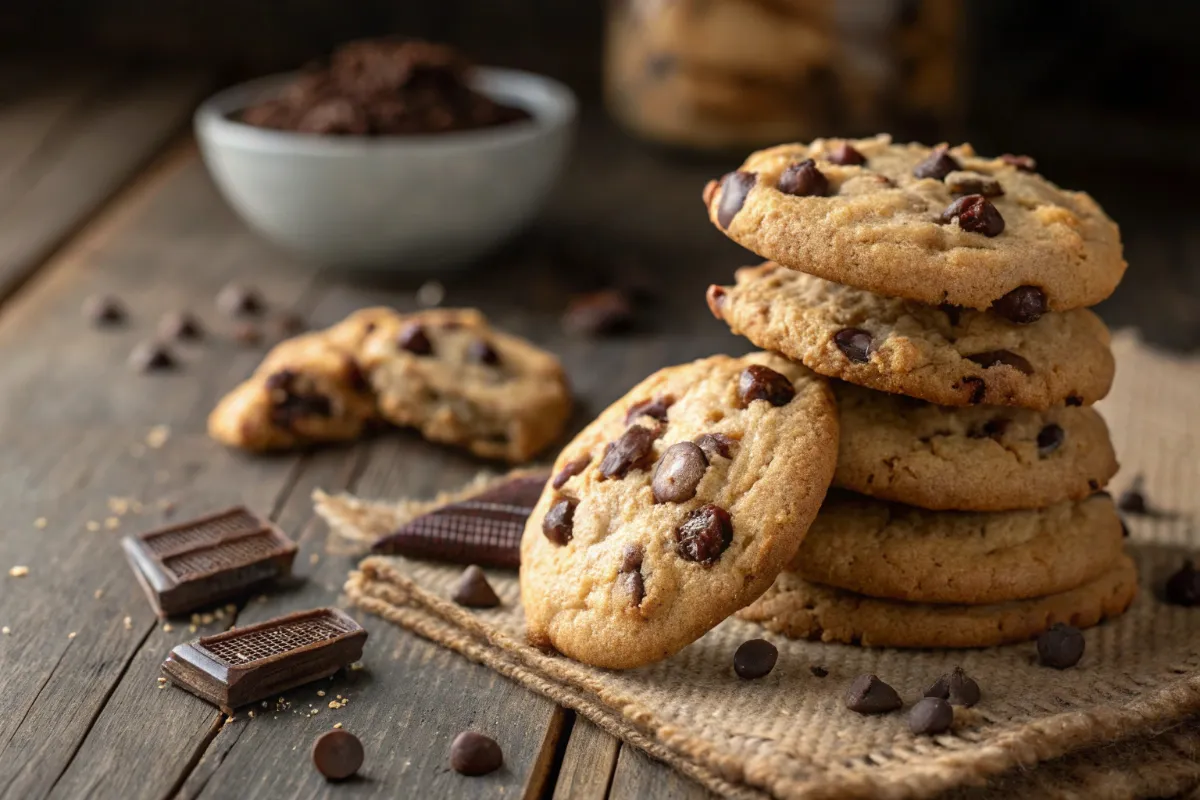Cottage cheese chocolate chip cookies might sound like an odd combo at first, but this unexpected pairing is winning hearts (and stomachs) for a reason. These cookies are soft, chewy, packed with protein, and offer a healthier spin on a nostalgic classic. Whether you’re a seasoned baker, a health-conscious dessert lover, or just curious about new kitchen experiments, this guide will walk you through everything you need to know.
From the science behind cottage cheese in baking to step-by-step instructions and storage tips, we’ve got it all. And if you’re wondering whether these cookies really taste like the real thing, you’re not alone—we’ll cover that too.
Don’t miss our Pumpkin Spice Latte Recipe if you love seasonal spins on classic favorites.
Introduction to Cottage Cheese Chocolate Chip Cookies
What Are Cottage Cheese Chocolate Chip Cookies?
Cottage cheese chocolate chip cookies are a fresh twist on the traditional treat. They include cottage cheese as a secret ingredient that adds moisture, boosts protein, and cuts down on fat. While the base remains similar—flour, sugar, eggs, and chocolate chips—the cottage cheese creates a richer, creamier bite.
Unlike standard cookies that depend heavily on butter or oil, this version balances out texture and nutrition in a clever way. It’s a perfect solution for cookie lovers seeking a healthier alternative without compromising taste or mouthfeel.
Why This Recipe is Gaining Popularity in 2025
In 2025, high-protein recipes and healthier baking swaps are taking over the dessert world. From TikTok trends to nutrition blogs, cottage cheese is becoming the star of guilt-free indulgence. These cookies fit right into that narrative—they’re satisfying, nutrient-rich, and easy to make.
Many health-focused home bakers are searching for ways to enjoy their favorite desserts without feeling weighed down. The natural creaminess and tang of cottage cheese provide an ideal base that allows you to skip some of the usual butter or oil.
Plus, baking enthusiasts are finding joy in experimentation. Blending cottage cheese into cookie dough offers a fresh spin that feels familiar but totally new—especially for those on high-protein diets or aiming to reduce refined fats.
In the next part, we’ll dive deeper into the health and nutrition benefits of using cottage cheese in baking.
Nutritional Benefits of Using Cottage Cheese in Cookies
High-Protein Baking: Cottage Cheese as a Nutritional Boost
One of the biggest reasons cottage cheese chocolate chip cookies have surged in popularity is their nutritional edge—particularly their protein content. Traditional cookies usually offer minimal protein, often derived from eggs or added nuts. But when you add cottage cheese into the mix, you’re introducing a high-quality source of complete protein.
Cottage cheese is packed with casein, a slow-digesting protein that keeps you full longer and supports muscle repair. A ½ cup serving of low-fat cottage cheese can provide around 14 grams of protein, making it an ideal ingredient for those following high-protein diets, fitness enthusiasts, or even kids who need sustained energy from snacks.
Not only does this help balance out the carb-heavy nature of most cookie recipes, but it also turns these cookies into a more functional food—something that tastes good and works harder for your body.
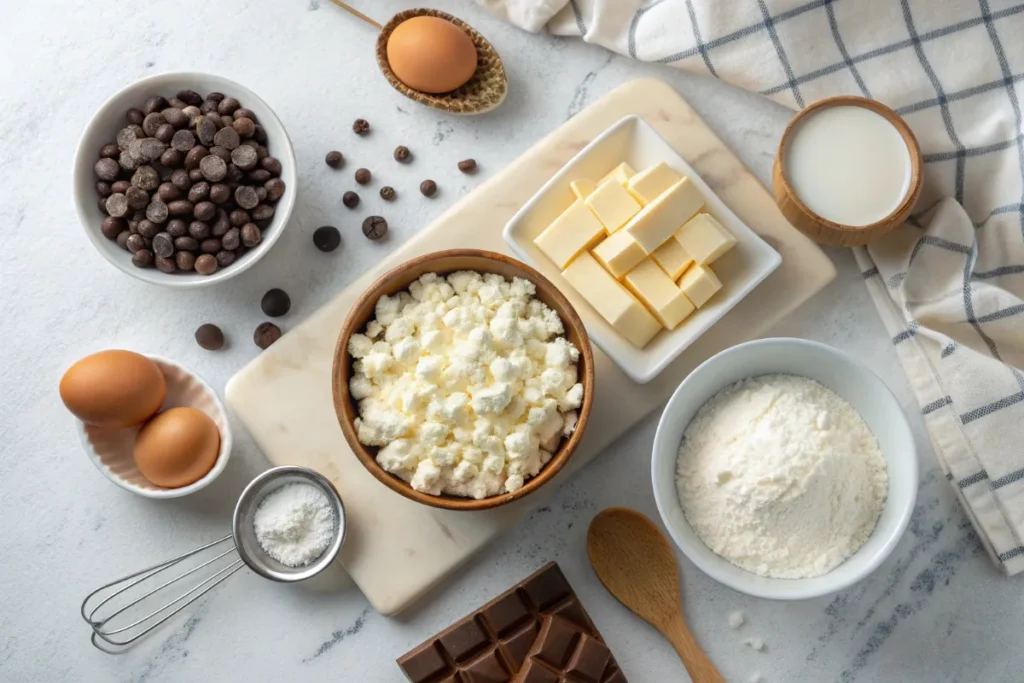
How Cottage Cheese Reduces Fat Without Sacrificing Moisture
Beyond the protein benefits, cottage cheese is a genius substitute for reducing saturated fat in baking. Unlike butter or shortening, cottage cheese adds creaminess and moisture without the heavy fat load. This swap is especially helpful for people watching their fat intake but still craving something indulgent.
Replacing a portion of butter with cottage cheese in your cookie dough creates a lighter, tender texture without drying out the final product. The result? Cookies that feel rich and satisfying without being greasy or overly dense.
Here’s a quick comparison table:
| Ingredient | Calories (per 1/4 cup) | Total Fat | Protein | Moisture Boost |
|---|---|---|---|---|
| Unsalted Butter | ~400 | 44g | 0g | ❌ |
| Full-Fat Cottage Cheese | ~50 | 2g | 7g | ✅ |
| Low-Fat Cottage Cheese | ~40 | 1g | 8g | ✅ |
This shows why many bakers are choosing to replace 25%–50% of the butter in cookie recipes with cottage cheese to strike a delicious balance between health and flavor.
Discover great ideas like Is Pickle Pizza Actually Good? — another unexpected healthy twist.
Next, we’ll explore how these cookies taste and feel compared to traditional chocolate chip cookies. That’s where the magic really happens.
Taste and Texture – Do They Really Taste Like Regular Cookies?
Understanding the Flavor Profile: Creamy, Tangy, Sweet
Let’s be honest—cottage cheese in cookies sounds weird at first. But the truth is, once baked into the dough, most people can’t even tell it’s there. If anything, it enhances the flavor. The mild tanginess of cottage cheese complements the rich sweetness of the chocolate chips, giving the cookie a more balanced, almost gourmet taste.
Expect a slightly creamy flavor with a faint tang in the background—nothing overpowering or cheesy. It’s subtle enough that even picky eaters or kids won’t notice it’s not your typical cookie. In fact, many people say the flavor reminds them of bakery-style cookies, but with a smoother bite.
And no, it doesn’t taste like a cheese dessert or a cheesecake—this isn’t a sweet dairy bomb. Cottage cheese simply adds depth to the profile while letting the vanilla and chocolate shine.
Texture Talk: Soft, Moist, and Slightly Chewy
Texture-wise, this is where cottage cheese chocolate chip cookies stand out.
Thanks to the natural moisture in cottage cheese, the cookies come out soft in the center with a gentle chew. Think melt-in-your-mouth soft, not cakey. If you’re someone who enjoys bakery-style cookies with a slightly underbaked middle and a lightly crisped edge, you’re going to love this texture.
Here’s what to expect:
- Exterior: Lightly golden and crisp at the edges
- Interior: Moist, chewy, and never dry
- Overall bite: Creamy-rich mouthfeel with soft resistance
This is especially great for those who dislike crunchy or overly crumbly cookies. And the texture holds up well, even after storing or freezing—unlike many “healthy” cookies that turn rubbery over time.
If you like soft-baked cookies from the grocery store but wish they had more substance, these are your upgrade.
Check out Where to Buy Pickle Pizza for more unconventional food trends making headlines.
Next up: get your apron ready—we’re diving into the exact recipe with steps, ingredient swaps, and pro tips.
Recipe – How to Make Cottage Cheese Chocolate Chip Cookies
Ingredients You’ll Need (With Substitution Options)
To make these soft, high-protein cookies, you’ll need just a few pantry staples—and of course, cottage cheese. Here’s the core ingredient list:
Basic Ingredients
- 1 cup all-purpose flour
- ½ teaspoon baking soda
- ¼ teaspoon salt
- ½ cup unsalted butter (softened)
- ⅓ cup granulated sugar
- ⅓ cup brown sugar (for chewiness)
- 1 large egg
- 1 teaspoon vanilla extract
- ½ cup full-fat or low-fat cottage cheese (blended smooth)
- ¾ cup semi-sweet chocolate chips
Optional Swaps & Add-Ins
| If You Want… | Swap or Add: |
|---|---|
| Higher protein | Use protein-enriched flour or add 1 tbsp whey protein |
| Lower fat | Replace butter with applesauce (50%) |
| Less sugar | Use monk fruit or coconut sugar |
| Gluten-free | Use 1:1 gluten-free baking flour |
| Dairy-free | Use dairy-free cottage cheese or soft tofu |
| Extra crunch | Add walnuts, almonds, or sunflower seeds |
Step-by-Step Instructions for the Best Results
This is a beginner-friendly recipe. You don’t need a mixer—just a bowl, a whisk, and a spatula.
- Preheat oven to 350°F (175°C). Line a baking sheet with parchment paper.
- In a small bowl, whisk together flour, baking soda, and salt.
- In a larger bowl, cream together softened butter, granulated sugar, and brown sugar until light and fluffy.
- Add egg and vanilla extract. Mix until combined.
- Blend your cottage cheese in a blender or food processor until smooth, then add it to the wet mix. Stir gently.
- Slowly add the dry ingredients to the wet ingredients. Mix until just combined.
- Fold in the chocolate chips. Do not overmix.
- Use a cookie scoop or tablespoon to drop dough onto your baking sheet.
- Bake for 10–12 minutes or until the edges are golden and the centers look set but slightly soft.
- Let cool on the baking sheet for 5 minutes before transferring to a wire rack.
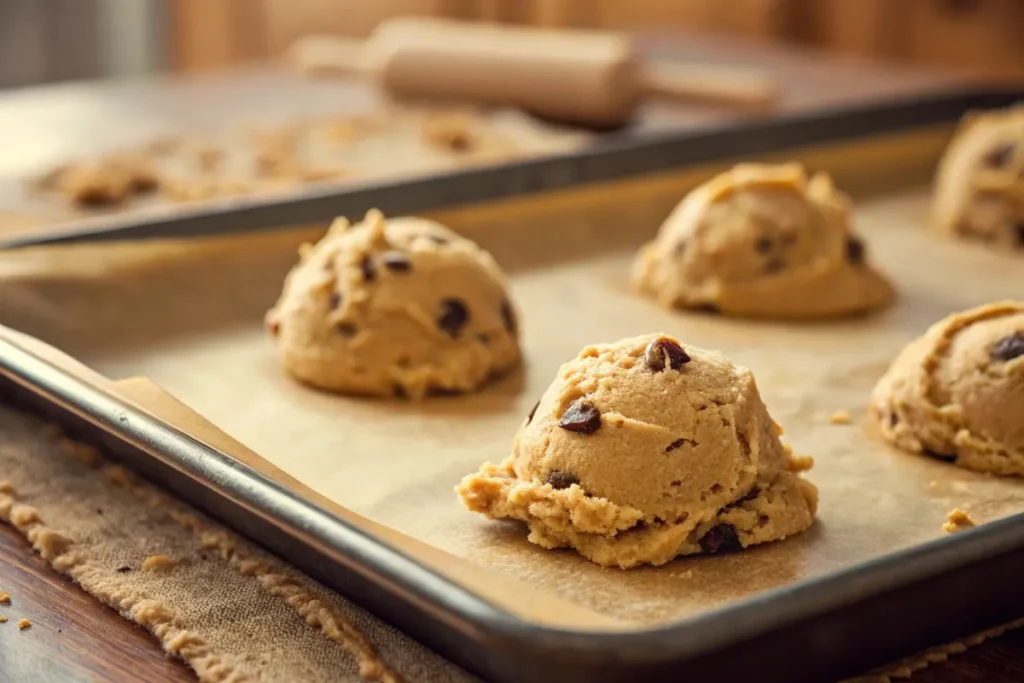
Tips for Texture: Soft, Chewy, Crispy Variations
Want to customize the texture? Here’s how:
| Texture Style | What to Do |
|---|---|
| Extra Chewy | Add 1 tbsp molasses and use brown sugar only |
| Soft & Cakey | Chill the dough for 30 minutes before baking |
| Crispy Edges | Flatten the dough slightly and bake an extra 2 mins |
| Fudgy Inside | Add an extra tablespoon of cottage cheese |
With just small adjustments, you can totally transform how these cookies bake and feel.
Looking for inspiration? Try Pickle Pizza on a Stick for another out-of-the-box recipe.
Next, we’ll tackle the most common question: can you really replace butter with cottage cheese in cookies?
Cottage Cheese as a Butter Substitute
Can You Replace Butter with Cottage Cheese in Cookies?
Absolutely—but there’s a bit of nuance. Cottage cheese can’t fully mimic the richness or structure that butter provides in cookies, but it’s an excellent partial substitute. When used properly, it adds creaminess, reduces fat, and boosts moisture.
Here’s what you need to know:
- Best practice: Replace up to 50% of the butter in your cookie recipe with smooth-blended cottage cheese.
- Full replacement? Possible, but not recommended for classic cookies—you’ll end up with more of a cakey or muffin-like texture.
- Blending is key: Always blend your cottage cheese until creamy before adding it to the dough. This prevents curd clumps and gives a smoother final texture.
Here’s a general ratio guide:
| Original Butter | Substitute With: |
|---|---|
| 1 cup butter | ½ cup butter + ½ cup blended cottage cheese |
| ½ cup butter | ¼ cup butter + ¼ cup cottage cheese |
This mix works well for soft cookies like chocolate chip, oatmeal, or peanut butter, but may not perform as well in crispy cookie recipes where butter is vital for that snap.
Best Ratios for Substitution + When It Works Best
Use these ratio tips depending on your baking goal:
| Goal | Suggested Swap | Result |
|---|---|---|
| Cut fat, keep flavor | 70% butter + 30% cottage cheese | Slightly softer, still rich |
| Maximize moisture & softness | 50% butter + 50% cottage cheese | Soft and chewy with creamy notes |
| Light & fluffy texture | 100% cottage cheese (not ideal for cookies) | Cakey, not cookie-like |
It works best in drop cookie recipes where a softer texture is desired. For roll-out or cut-out cookies, you’ll need the fat structure that butter offers.
By carefully balancing the ratio, you’ll get high-protein, lower-fat cookies that don’t taste like a “healthy compromise.”
Next, we’ll answer a crucial question many readers have: Are cottage cheese chocolate chip cookies actually healthy?
Healthier Baking with Cottage Cheese
Are Cottage Cheese Cookies Actually Healthier?
Short answer: Yes—but with caveats. Cottage cheese chocolate chip cookies are definitely a healthier version of the classic, but they’re still cookies at heart. Let’s break it down.
By incorporating cottage cheese, you naturally reduce the need for large amounts of butter or oil, cutting saturated fat while increasing protein. That makes each bite more nutrient-dense and satisfying.
However, they still contain:
- Refined flour
- Sugars (brown and white)
- Chocolate chips (which add sugar and fat)
So while not a “superfood,” these cookies are a smarter indulgence—a balance between traditional baking and mindful eating.
Macros Breakdown: Protein, Fat, Sugar, and Calories
Let’s look at a typical cookie made using 50% cottage cheese instead of full butter (per 1 cookie, approx. 2.5” diameter):
| Nutrient | Amount | Compared to Traditional |
|---|---|---|
| Calories | 120–140 | 20% less |
| Protein | 4–5g | 2x more |
| Total Fat | 6g | 30–40% less |
| Sugar | 9–10g | Slightly less |
| Carbs | 15g | Similar |
These numbers can vary depending on your exact ingredient choices, but even small swaps add up—especially for those baking regularly.
Healthier Swap Suggestions (Gluten-Free, Sugar-Free, etc.)
Want to take things even further? You can adjust your recipe to suit different dietary goals without sacrificing the soft, chewy appeal.
Here are some healthy substitutions you can try:
| Ingredient to Replace | Healthier Option | Result |
|---|---|---|
| All-purpose flour | Almond flour or oat flour (GF) | Slightly denser but rich in fiber |
| Sugar | Coconut sugar, monk fruit sweetener | Lower GI, natural alternatives |
| Chocolate chips | Dark chocolate or cacao nibs | Less sugar, more antioxidants |
| Butter | Mashed banana or avocado (partial) | Adds fiber, nutrients, fewer fats |
| Egg | Flax egg or chia egg (vegan) | Lower cholesterol, plant-based |
By making even one or two of these swaps, you can transform your cookies into something that fits a gluten-free, low sugar, or dairy-light lifestyle.
These cookies are especially appealing for people following high-protein diets, low-fat meal plans, or those with sensitive digestion, since cottage cheese is easier on the gut compared to heavier dairy like cream cheese or butter.
Up next, we’ll walk through which type of cottage cheese works best—because it absolutely makes a difference.
Choosing the Right Cottage Cheese for Baking
Small Curd vs. Large Curd: Which Is Better?
When it comes to baking cottage cheese chocolate chip cookies, texture matters, and the type of cottage cheese you use plays a big role in the final result.
Small curd cottage cheese is hands-down the better choice for cookies. Why?
- It blends more smoothly
- It incorporates into dough without visible clumps
- It creates a creamier, uniform texture
Large curd varieties often leave behind noticeable lumps, even after blending, which can lead to uneven cookie structure and bite.
If you’re after a silky dough and a consistent cookie texture, go for small curd every time. And for the best results, blend it until completely smooth before adding it to your wet ingredients.
Full-Fat vs. Low-Fat Cottage Cheese: Impact on Cookies
Choosing between full-fat and low-fat cottage cheese? Here’s the breakdown:
| Type | Pros | Cons |
|---|---|---|
| Full-fat | Creamier texture, richer flavor | Slightly more calories and fat |
| Low-fat (1% or 2%) | Fewer calories, still provides moisture | May result in slightly drier texture if overbaked |
| Fat-free | Lowest calorie option | Can be watery and less flavorful |
For most home bakers, low-fat (2%) cottage cheese strikes the best balance. It provides moisture and protein without too much fat, and it blends well into dough.
Avoid fat-free unless you’re also reducing sugar and fat elsewhere in the recipe—it may affect structure and flavor negatively.
💡 Pro Tip: If you only have large curd or fat-free cottage cheese, blend it thoroughly with a splash of milk or Greek yogurt for a creamier, richer base.
Storage and Freezing Tips
How to Store Cottage Cheese Chocolate Chip Cookies
These cookies are moist and tender thanks to the cottage cheese, but that also means they need proper storage to stay fresh and flavorful.
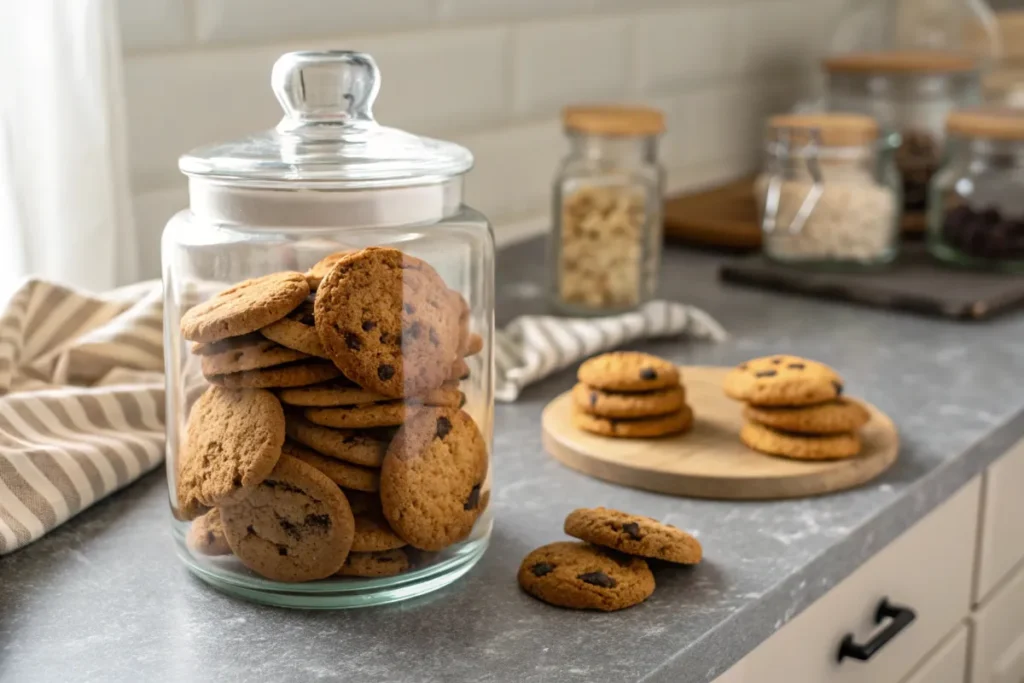
Room Temperature (Best for short-term):
- Store cookies in an airtight container at room temperature.
- Keep them out of direct sunlight or heat.
- Cookies stay fresh and soft for about 3–4 days.
Refrigeration (Best for humid climates or longer shelf life):
- Store in an airtight container or zip-lock bag.
- Keep refrigerated for up to 1 week.
- Let cookies sit at room temp for 10–15 minutes before eating to restore softness.
Don’t miss our Pumpkin Spice Latte Recipe for the perfect cozy drink to pair with these cookies!
Freezing, Reheating, and Batch Baking Suggestions
Want to bake ahead? Good news—these cookies freeze beautifully.
Freezing Baked Cookies:
- Cool cookies completely before freezing.
- Store in a zip-lock freezer bag with parchment paper between layers.
- Freeze for 2–3 months.
- To serve: Let thaw at room temp or microwave for 10–15 seconds for a just-baked taste.
Freezing Dough:
- Scoop dough into balls and place on a baking sheet.
- Freeze until solid, then transfer to a zip-lock bag.
- Label with date. Bake straight from frozen (add 1–2 minutes to bake time).
Freezing dough is a great option if you want portion-controlled baking or warm cookies anytime, without the full prep.
Whether you bake now or later, cottage cheese chocolate chip cookies keep their soft, chewy texture and don’t dry out like some low-fat cookies do after freezing.
Variations and Creative Twists
Gluten-Free, Protein-Packed, or Vegan? Here’s How
The base recipe for cottage cheese chocolate chip cookies is super versatile, which makes it easy to tweak for different dietary preferences. Whether you’re going gluten-free, need more protein, or want a plant-based option, here’s how to do it without sacrificing flavor or texture.
✅ Gluten-Free Version
- Swap all-purpose flour with a 1:1 gluten-free baking blend.
- For extra fiber, use a mix of almond flour + oat flour (50/50).
- Add ¼ tsp xanthan gum if your mix doesn’t include it for binding.
✅ High-Protein Version
- Replace ¼ cup of flour with unflavored whey or casein protein powder.
- Use Greek-style cottage cheese for extra protein density.
- Add chopped almonds or hemp seeds for texture and a protein boost.
✅ Dairy-Free / Vegan Version
- Use plant-based cottage cheese (available in almond or soy versions).
- Replace egg with a flax egg (1 tbsp ground flax + 3 tbsp water).
- Swap butter with refined coconut oil or vegan margarine.
- Use dairy-free chocolate chips.
Add-In Ideas: Nuts, Oats, Dark Chocolate, or Coconut
Once you’ve nailed the base recipe, you can get creative. Here are some of the best flavor additions that pair perfectly with the creamy tang of cottage cheese:
| Add-In | Amount | Flavor Profile |
|---|---|---|
| Chopped Walnuts | ½ cup | Earthy crunch, extra protein |
| Rolled Oats | ¾ cup | Chewy texture, whole-grain boost |
| Shredded Coconut | ½ cup | Sweet, tropical flavor |
| Dark Chocolate Chunks | ¾ cup | Richer, less sweet chocolate taste |
| Dried Cranberries | ½ cup | Tart contrast, chewy bite |
| Cinnamon or Nutmeg | ½ tsp | Warm spice profile |
💡 Tip: Combine multiple add-ins (like oats + dark chocolate + walnuts) for a power cookie that hits every flavor and texture note.
These variations allow you to tailor the cookie to your mood, occasion, or nutritional goal—whether you want indulgent, healthy, or something in between.
Frequently Asked Questions (FAQs)
Do cottage cheese chocolate chip cookies actually taste like regular cookies?
Yes, they do—with a twist. Cottage cheese gives these cookies a slightly tangy and creamy undertone, but it doesn’t overpower the familiar sweet, chocolatey flavor. In fact, many people say the addition enhances the taste, making it more balanced. You still get the indulgent, chewy goodness of a classic chocolate chip cookie—just with a richer mouthfeel and softer bite.
Why add cottage cheese to chocolate chip cookies?
Cottage cheese adds multiple benefits:
– Protein boost: Each cookie contains more protein than traditional recipes.
– Lower fat: Swapping in cottage cheese cuts saturated fat.
– Extra moisture: It makes the cookies soft and pillowy.
– Improved texture: The end result is chewy and rich, not greasy.
It’s a small change that makes a big difference both nutritionally and texturally.
Can I replace butter with cottage cheese in cookies?
Yes—but only partially. Cottage cheese works best when it replaces 25% to 50% of the butter. Fully replacing butter can lead to cakey cookies. Blending the cottage cheese until smooth ensures it integrates well. Use ½ cup butter + ½ cup cottage cheese for best results in a standard batch.
Are cottage cheese chocolate chip cookies healthy?
Healthier than traditional cookies—yes. Healthy overall? Depends on your definition.
They’re lower in fat and higher in protein, but still contain sugar and refined flour. You can make them healthier by swapping ingredients:
– Use coconut sugar or monk fruit sweetener
– Try whole wheat or oat flour
– Add nuts or seeds for fiber and healthy fat
They’re ideal for anyone wanting a more balanced indulgence.
What type of cottage cheese works best for cookies?
Go with small curd, low-fat or full-fat cottage cheese. Always blend it smooth before adding it to your dough. Small curd blends better and integrates into the batter without leaving chunks. Avoid fat-free unless you’re adjusting other ingredients to make up for lost richness.
How do I store cottage cheese chocolate chip cookies?
– Room Temp: Airtight container, 3–4 days
– Refrigerator: Up to 1 week
– Freezer: Freeze in layers (with parchment) for 2–3 months
– To reheat, microwave for 10–15 seconds or warm in a low oven.
Proper storage helps maintain their soft, chewy texture—no stale cookies here.
Conclusion: Why Cottage Cheese Chocolate Chip Cookies Deserve a Spot in Your Recipe Box
Cottage cheese chocolate chip cookies are the perfect blend of nostalgic comfort and modern nutrition. With their creamy texture, high protein content, and reduced fat, they’re a smart choice for anyone craving something sweet without going all-in on sugar and butter.
Whether you’re a weekend baker, a parent packing lunchbox treats, or a fitness-focused foodie, this recipe offers something new and rewarding. It’s simple to make, fun to customize, and even easier to fall in love with.
Don’t miss our Pumpkin Spice Latte Recipe—a cozy drink that pairs perfectly with a warm batch of these cookies.
Print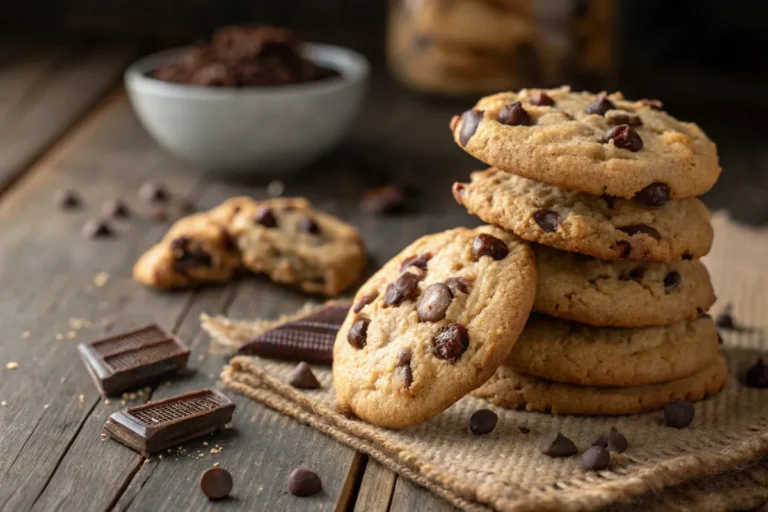
Cottage Cheese Chocolate Chip Cookies: High-Protein Twist on a Classic Treat
These Cottage Cheese Chocolate Chip Cookies are a high-protein twist on the classic favorite. Soft, chewy, and packed with rich flavor, they blend indulgence with a healthy edge.
- Total Time: 22 minutes
- Yield: 16 cookies 1x
Ingredients
- 1 cup all-purpose flour
- ½ teaspoon baking soda
- ¼ teaspoon salt
- ½ cup unsalted butter (softened)
- ⅓ cup granulated sugar
- ⅓ cup brown sugar
- 1 large egg
- 1 teaspoon vanilla extract
- ½ cup full-fat or low-fat cottage cheese (blended smooth)
- ¾ cup semi-sweet chocolate chips
Instructions
- Preheat oven to 350°F (175°C) and line a baking sheet with parchment paper.
- In a small bowl, whisk together flour, baking soda, and salt.
- In a larger bowl, cream together butter, granulated sugar, and brown sugar until light and fluffy.
- Add egg and vanilla extract, and mix until combined.
- Blend cottage cheese until smooth and stir it into the wet mixture.
- Slowly add dry ingredients to wet, mixing until just combined.
- Fold in chocolate chips without overmixing.
- Drop spoonfuls of dough onto baking sheet.
- Bake 10–12 minutes or until edges are golden and centers are just set.
- Cool on baking sheet for 5 minutes, then transfer to a wire rack.
Notes
For extra softness, chill dough for 30 minutes before baking. Blend cottage cheese thoroughly to ensure smooth texture. Great for high-protein diets or anyone looking for a lighter cookie.
- Prep Time: 10 minutes
- Cook Time: 12 minutes
- Category: Dessert
- Method: Baking
- Cuisine: American
Nutrition
- Serving Size: 1 cookie
- Calories: 130
- Sugar: 10g
- Sodium: 90mg
- Fat: 6g
- Saturated Fat: 3g
- Unsaturated Fat: 2.5g
- Trans Fat: 0g
- Carbohydrates: 15g
- Fiber: 0.5g
- Protein: 4g
- Cholesterol: 20mg
Keywords: cottage cheese cookies, high protein dessert, healthy chocolate chip cookies

